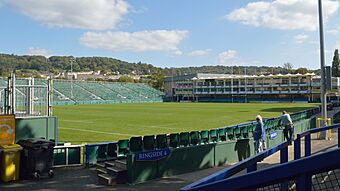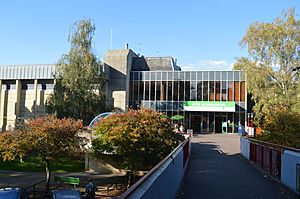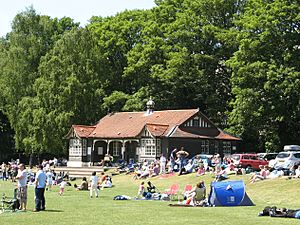Recreation Ground, Bath facts for kids
|
The Rec
|
|
 |
|
| Location | Bath, Somerset |
|---|---|
| Coordinates | 51°22′56″N 2°21′19″W / 51.38222°N 2.35528°W |
| Owner | The Recreation Ground Trust, Bath |
| Operator | Bath Recreation Ltd |
| Capacity | 14,509 |
| Surface | Grass |
| Opened | 1894 |
| Tenants | |
| 1894-present various |
|
The Recreation Ground, often called the Rec, is a big open space in the middle of Bath, England. It sits right next to the River Avon. This area is meant for everyone to use for fun activities, especially the people of Bath and nearby towns.
A large part of the Rec is used by Bath Rugby during the rugby union season. It becomes a sports field that can hold about 14,500 people! In the summer, the temporary rugby stands are taken down. This makes space for a bigger cricket pitch. This pitch is used for local cricket games. Other parts of the Rec are used by clubs for hockey, croquet, drama, and even Quidditch. There are also tennis courts and fields for amateur sports like football, volleyball, and lacrosse. You can find a cricket building near the William Street entrance. A sports and leisure center, run by the city council, is also on the southern edge of the Rec.
Years ago, the Rec often flooded from the River Avon. But in the 1960s, a project helped the river flow better. Even so, the Rec is still in a flood area and can get very muddy after heavy rain.
Contents
History of the Rec
In the early 1890s, the land where the Rec is now was part of a big estate owned by the Forester family. In 1894, a company called The Bath and County Recreation Ground Company Limited was allowed to use the land. They worked to make it ready for sports like cricket, tennis, archery, and football. The first Bath Rugby matches were played here in 1894.
Three years later, the Rec hosted its first big cricket match. Somerset County Cricket Club played against a team from Philadelphia. The company continued to lease the land for many years. In 1922, the company bought the land for £6,050.
In 1927, Bath F.C. was given a new lease to use the western part of the ground. This included a Grand Stand, a North Stand, and a Pavilion. Six years later, a new 50-year lease was granted. The old Grand Stand was replaced with a new West Stand. This stand was badly damaged during the Second World War. It was rebuilt in 1953-54 with money from the government. In 1956, the city of Bath bought the ground for £11,155.
The Bath Festival of Blues was held at the Rec on June 28, 1969. Famous bands like Fleetwood Mac and Led Zeppelin performed there!
In 1973, Bath F.C. received another 75-year lease. The city council built a Sports and Leisure Centre on the south side in 1975. In 1995, Bath F.C. got yet another 75-year lease. In 2002, a court decided that the Rec land was a special charitable trust. This meant it had to be kept as an "open space" for everyone to use for recreation.
On July 16, 2006, the Irish pop band Westlife held a concert at the Rec as part of their tour.
What is a Charitable Trust?
The Rec is now owned and managed by The Recreation Ground Trust. This trust is like a special guardian for the land. Until 2002, it wasn't completely clear how the Rec should be used. A court then decided it was a "charitable trust." This means the Rec must be kept as an "open space" and a "recreational facility" for everyone.
The rules of the trust say the Rec should be used for "games and sports of all kinds." It also says that no one sport or club should get special treatment.
| How the Rec was used in 2007 | |
|---|---|
| Open Space | 41% |
| Rugby Club (in season) |
27% |
| Council Sports and Leisure Centre |
17% |
| Croquet Club | 9% |
| Tennis Clubs | 5% |
| Drama Club | 1% |
Because of these rules, there were questions about whether Bath Rugby's use of the Rec fit with the trust's goals. The Charity Commission, which oversees charities, had to give special permission each year for the rugby club to use extra land. This was needed for professional rugby games while a long-term solution was being worked out.
The city council had built the Sports and Leisure Centre in 1975. But after the 2002 court decision, the Charity Commission said this might not follow the trust's rules for "open air recreation."
The Future of Bath Rugby at the Rec
Around 2006, rules for professional rugby clubs changed. They needed bigger stadiums. The Rec's capacity was too small for Bath Rugby at the time. This started a long discussion about how the club could stay at the Rec and expand.
Many ideas were suggested. One big idea was a "land swap." This meant Bath Rugby would give its training ground at Lambridge to the trust. In return, the trust would allow the rugby club to use more land at the Rec. This would help correct past issues with how the land was used.
In 2011, the Trustees of the Recreation Ground asked the public what they thought about the land swap idea. Over 4,000 people responded, and 86% were in favor of the plan.
In 2012, the Charity Commission agreed in principle to the land swap. This would allow the club to expand its area at the Rec. The training ground at Lambridge would become public land.
However, there were still legal challenges. Some local residents were worried about building on the Rec. In 2013, a local resident tried to have the Rec declared a "Town Green," which would have made building much harder. This application was refused.
In 2014, a court allowed the land swap plan with some changes. The rugby club's expansion was limited to the area they already used. Even with this limit, the club felt it could still build a stadium for about 16,000 people.
In 2015, the Trustee Board won an appeal. This decision allowed the Trustees more freedom to manage the Rec for the public, following its charitable goals.
A new plan was agreed upon in 2016. It said:
- The Trust must provide "outdoor recreational facilities for the public."
- It should mainly be used for "games and sports of all kinds," but without favoring any one sport or club too much.
- The Rec must stay an "open space," but it doesn't have to look exactly as it does now.
- The Trust can sell, lease, or swap parts of the Rec for other land near Bath.
- When the leisure center is old and no longer useful, it must be taken down.
In 2020, a court ruled that old rules from 1922 could stop new buildings on the Rec if they bothered neighbors. This was a setback for the rugby club's plans. But in December 2021, an Appeal Court disagreed with that ruling. They said the old rules weren't clear enough to stop building. This was a big step forward for the rugby club.
In October 2022, the highest court, the Supreme Court, refused to hear another appeal. This meant the legal battles over building on the Rec were finally over. The rugby club could now move forward with its plans to build a new stadium, as long as they got planning permission from the council.
Tarquin MacDonald, the CEO of Bath Rugby, said they were "delighted" with the ruling. He explained that a new stadium would create jobs, bring more visitors to Bath, improve the river area, and help young people.
In September 2023, Bath Rugby submitted a plan for an 18,000-seat rugby stadium. It would also include spaces for conferences and events.
Groups Interested in the Rec
There are different groups who care about the Rec's future:
Real Friends of the Rec
This group started in 2008. They want to see a sports and cultural arena built at the Rec. They hope this new stadium would be used all year round for cricket and other sports, bringing in more money and activities. This group supported the idea of the land swap.
Friends of Bath Recreation Ground
This is another group of local residents. They believe the Rec should not be used for professional sports. They have concerns about the council's past actions regarding the Rec. They have said they might take legal action if the Trust and Bath Rugby agree to new building plans.
When the plans for the 18,000-seat stadium were submitted in 2023, this group raised concerns. They worried that such a tall and large building would block famous views of Bath. They felt this could even threaten Bath's special status as a UNESCO World Heritage Site.
See also
 In Spanish: The Recreation Ground para niños
In Spanish: The Recreation Ground para niños






